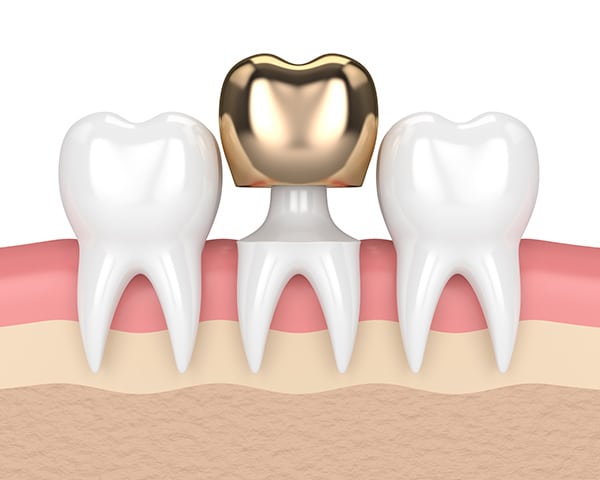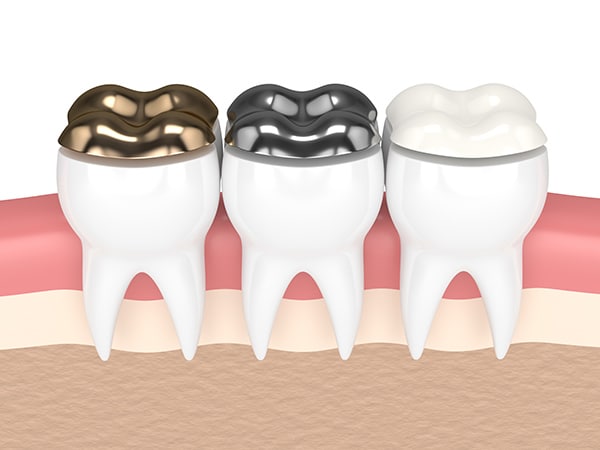Dental Crowns in Broomfield, CO
Dental Crowns, Core Build-Up, Inlays/Onlays (Partial Crowns)
Dental crowns are a protective covering that shield and protect your teeth. It looks exactly like a tooth and restores it to its normal shape, size, function and is generally the same color. They are part of the many cosmetic dentistry services we offer.

What Are Dental Crowns Made Of?
Crowns are either made of metals, resins, or ceramics.
Below are the most common types of dental crowns
How Long Do Dental Crowns Last?
This is a complicated question. Dental crowns are not invincible, they are like your natural teeth and when neglected or without proper care, can form another cavity underneath. If you bite into something very hard, open a bottle or a jar for example, they can break. Some older crowns may show open margins, which is spacing between the tooth and the crown. Within these openings, bacteria and saliva may enter and cause a new cavity. This can be detected by radiographic x-rays and tactile. Early detection of these instances can help avoid further extensive treatment, such as a root canal.
With proper care (brushing/flossing) and proper maintenance (bi-yearly cleanings) crowns can last years and maybe even a lifetime. Insurance will usually cover a crown every 5 years. Longevity can be maintained with routine care and careful monitoring by your dentist. This is why seeing a preventive dentist is crucial.
Crown Diagnosis
Do I Really Need Dental Crowns?
A crown may be recommended or indicated when you:
What Can Happen If I Don’t Get a Crown When One Was Recommended?
When more than a fourth of your tooth is significantly damaged or compromised and/or is supported with more dental material than tooth, it can cause a lot of stress. This type of stress can lead to tooth fractures, resulting in situations where further treatment (such as a root canal) may be needed. It can also result in a tooth that was once savable no longer being savable.
Placing a Crown Over a Fragile Unsupported Tooth Helps Distribute Biting Force More Evenly, Providing Strength and Support
A root canal treated molar is great example of a fragile tooth. The tooth is very brittle and weak since there is not enough remaining healthy tooth structure for support. Your molars are the back teeth that bear most of the forces and need the strongest protection. If you are constantly putting pressure or force on a weakened tooth it will be bound to break. This is why it is important to consult with your dentist for the best preventive outcome.
Dental Crown Treatment
What Is the Process of Applying a Crown? Does It Hurt?
The process of a crown is similar to a tooth colored filling. Local anesthetic is administered so you will not feel any pain during the procedure. Your dentist should make sure you are completely comfortable in the chair. In general, the procedure takes about an hour, but can take longer depending on how extensive the cavity or fracture is.
Usually the dental crown is a two-appointment process that consists of two main steps: preparation and final cementation
Preparation Stage
- The dentist prepares the tooth by removing any large cavity, existing filling material or fracture.
- A core build-up is placed when a large cavitation or fracture is present so that you are not left with a large hollow hole. A core build-up is material placed for strength and support of the tooth and crown. In some cases, it may not be necessary.
- An impression is taken to provide the lab the exact model in order to fabricate the crown. Impressions can be made by a mold or a digital scanner.
- A temporary crown is placed in the meantime during the lab’s fabrication of the crown. This will shield and protect the tooth for a couple of weeks. While the temporary crown is in, it is important to avoid direct contact, chewing crunchy, hard, or taffy-like things to prevent the temporary crown from breaking or coming off. Since the tooth has been worked on, patients will usually feel some soreness around the gums in that area and may have some hot/cold sensitivity. These symptoms usually resolve after a couple of days.
Cementation
Once the dental crown is back from the lab, the dentist will make sure your crown properly fits, and is adjusted to your original bite. The fit can be double checked by taking a radiographic x-ray before the crown is permanently cemented. Once it is permanently cemented you will be able to go back to chewing properly and flossing regularly in that area.
Core Build-Up
A core build-up is a resin-based restoration used to hold together remaining tooth structure that has decayed or been damaged.
When there is an extensive cavity or damage, the damaged part of your tooth will be removed. In order for the tooth to hold its strength, it will need something (core build-up) to fill that space. If nothing is placed, the tooth would have a hollow hole and be susceptible to fracture.
A core-build procedure is similar to a filling. Many times a core build-up is placed during crown preparation. This is so there is enough tooth structure to hold up the crown to be cemented for stability and strength.
Indications of Core Build-Up:
Inlays/Onlays (Partial Crowns)
What Is an Inlay?
An inlay is an indirect custom-made filling/restoration to fill a part of a tooth that has been damaged or decayed. The design of an inlay is structured that the filling is confined within the cusps (tips/bumps) of the tooth. It is similar to a filling in that it can be bonded.
What Is an Onlay?
An onlay is the same as an inlay with the exception that the design is structured that the filling extends over the cusps of the tooth.

What Types of Inlays and Onlays Are There?
Both inlays and onlays are made of porcelain, gold or composite resin material. Below is a table describing some pros and cons to each of the materials.
Porcelain Inlays/Onlays
Pros
Cons
Gold Inlays/Onlays
Pros
Cons
Composite Inlays/Onlays
Pros
Cons
What Is the Process of an Inlay or Onlay? Does It Hurt?
The process of an inlay or onlay is similar to a crown preparation. Local anesthetic is administered so you will not feel any pain during the procedure. Your dentist should make sure you are completely comfortable in the chair. In general, the procedure takes about an hour but can take longer depending on how extensive the cavity or fracture is.
Usually the inlay or onlay is a two-appointment process that consists of two main steps: preparation and final cementation/bonding)
Preparation Stage
- The dentist prepares the tooth by removing any large cavity, existing filling material or fracture.
- An impression is taken to provide the lab the exact model in order to fabricate the crown. Impressions can be made by a mold or a digital scanner.
- A temporary inlay or onlay is placed in the meantime during the lab’s fabrication of the restoration. This will shield and protect the tooth for a couple of weeks. While the temporary restoration is in, it is important to avoid direct contact, chewing crunchy, hard, or taffy-like things to prevent the temporary restoration from breaking or coming off. Since the tooth has been worked on, patients will usually feel some soreness around the gums in that area and may have some hot/cold sensitivity. These symptoms usually resolve after a couple of days.
Cementation/Bonding
Once the inlay or onlay is back the dentist will make sure your restoration properly fits, and is adjusted to your original bite. The fit can be double checked by taking a radiographic x-ray before the restoration is permanently cemented or bonded. Once it is permanently cemented/ bonded you will be able to go back to chewing properly and flossing regularly in that area.
Cosmetic & Restorative Dentistry
Schedule Your Cosmetic Dentistry Appointment with Clear Dental Studio Today!
If you live in Broomfield, CO, & surrounding areas and are in need of a dental evaluation, cleaning, assessment or any other dental services, turn to Clear Dental Studio. Dr. Martha Ha and her team of dental specialists are known for performing exceptional dental work for the residents of Broomfield and beyond and can do the same for you! Whether you need cosmetic, restorative, preventive, or surgery-oriented dental services, the choice is Clear. Call us today or book online to schedule an appointment at our Broomfield office.
